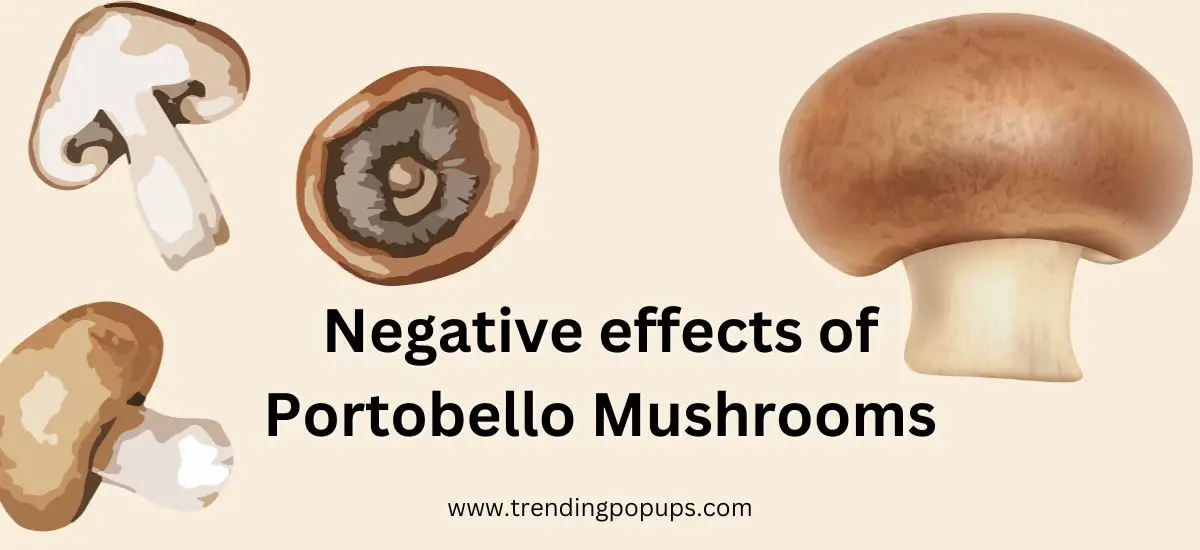Portobello mushrooms, with their robust flavor and meaty texture, have become a staple in many kitchens around the world. These fungi are not only delicious but also pack a punch in terms of nutritional benefits. However, like any food, moderation is key. In this article, we’ll explore the negative effects of portobello mushrooms and how to enjoy them responsibly.
Understanding Portobello Mushrooms
Before we dive into the potential drawbacks, let’s take a moment to appreciate what makes portobello mushrooms so popular. These large, mature cremini mushrooms are a rich source of essential nutrients, including vitamins, minerals, and antioxidants. They are low in calories, high in fiber, and offer a variety of health benefits when consumed in moderation.
Negative Effects of Portobello Mushrooms
- Purine Content: Portobello mushrooms, like some other foods, contain purines. Purines are natural compounds that, when broken down in the body, form uric acid. Excessive uric acid can lead to conditions like gout, a type of arthritis. While portobello mushrooms are not the highest purine-containing food, individuals with gout or a history of kidney problems may need to monitor their intake.
- Tyramine Presence: Tyramine is an amino acid that naturally occurs in certain foods, including aged or fermented products. Portobello mushrooms have been found to contain tyramine, which can be a concern for individuals sensitive to this compound. Tyramine has been linked to headaches and migraines in some people. If you are prone to these conditions, it might be worth paying attention to your mushroom intake.
- Digestive Sensitivity: While portobello mushrooms are generally well-tolerated, some individuals may experience digestive issues such as bloating, gas, or upset stomach after consuming them. This can be attributed to the mushroom’s fiber content, which may be challenging for some people to digest, especially if they have a sensitive digestive system.
- Cholesterol and Sodium Levels: Portobello mushrooms are naturally low in cholesterol and sodium. However, the way they are prepared can impact their nutritional profile. If cooked with excessive amounts of butter, oil, or high-sodium seasonings, the overall health benefits may be compromised. It’s essential to choose cooking methods that preserve the mushrooms’ nutritional value.
- Allergic Reactions: While rare, some individuals may be allergic to mushrooms, including portobellos. Allergic reactions can range from mild symptoms like itching and swelling to more severe reactions such as difficulty breathing. If you suspect a mushroom allergy, it’s crucial to seek medical attention promptly.
Tips for Responsible Portobello Mushroom Consumption
- Moderation is Key: Enjoy portobello mushrooms in moderation, especially if you have pre-existing health conditions such as gout or kidney issues. This allows you to savor their flavor without overloading your system with certain compounds.
- Diversify Your Diet: Don’t rely solely on portobello mushrooms for your nutritional needs. Incorporate a variety of fruits, vegetables, and other sources of protein to ensure a well-balanced diet.
- Be Mindful of Preparation: Opt for healthier cooking methods such as grilling, roasting, or sautéing with minimal added fats and sodium. This preserves the mushrooms’ nutritional value and reduces the risk of negative effects.
- Monitor Allergic Reactions: If you suspect a mushroom allergy, be vigilant about monitoring any adverse reactions. Seek medical advice promptly if you experience symptoms like itching, swelling, or difficulty breathing.
Conclusion
In conclusion, while portobello mushrooms offer numerous health benefits, it’s essential to be aware of their potential negative effects. By consuming them in moderation, being mindful of your overall diet, and paying attention to preparation methods, you can continue to enjoy the rich flavor and nutritional goodness of portobello mushrooms without compromising your health. Remember, balance is the key to a healthy and satisfying culinary experience.
FAQs
Q. What are the negative side effects of portobello mushrooms?
- Purine Content: Portobello mushrooms contain purines, which can lead to increased uric acid levels. Individuals with gout or kidney issues should monitor their intake.
- Tyramine Presence: The presence of tyramine in portobellos may trigger headaches or migraines in sensitive individuals. Those prone to these conditions should be cautious.
- Digestive Sensitivity: Some people may experience digestive issues like bloating or gas after consuming portobello mushrooms due to their fiber content.
- Cholesterol and Sodium Levels: While naturally low in cholesterol and sodium, cooking methods involving excessive fats or sodium can impact the overall nutritional profile.
- Allergic Reactions: Rare but possible, allergic reactions to mushrooms, including portobellos, can range from mild itching to severe breathing difficulties. Immediate medical attention is crucial if an allergy is suspected.
Q. Are portobello mushrooms good or bad?
Portobello mushrooms are generally a healthy addition to your diet when consumed in moderation and prepared mindfully. Enjoy their nutritional benefits, but be aware of potential sensitivities and ensure a balanced overall diet.
Portobello Mushrooms: The Good and the Bad
The Good:
- Rich in nutrients, low in calories.
- Excellent source of fiber, aiding digestion.
- Contains antioxidants with potential health benefits.
- Versatile in cooking, providing a meaty texture for plant-based dishes.
The Bad:
- Moderate purine content, may be a concern for those with gout or kidney issues.
- Tyramine presence could trigger headaches in sensitive individuals.
- Some may experience digestive issues due to the fiber content.
- Nutritional profile can be compromised if prepared with excessive fats or sodium.
Q. What is controversial about portobello mushrooms?
Controversies Surrounding Portobello Mushrooms: A Brief Overview
- Purine Levels: The purine content in portobello mushrooms raises concerns for individuals with conditions like gout or kidney problems, prompting the need for moderation.
- Tyramine Sensitivity: Some people, particularly those prone to headaches or migraines, may need to be cautious due to the presence of tyramine in portobellos.
- Digestive Sensitivity: While generally well-tolerated, the fiber content in portobello mushrooms may lead to digestive issues in certain individuals.
- Allergies: Although rare, allergic reactions to mushrooms, including portobellos, can occur, emphasizing the importance of awareness and monitoring for potential allergies.
In essence, while portobello mushrooms offer numerous benefits, these controversies highlight the importance of individual considerations and moderation in their consumption.
Q. What happens if you eat too much portobello mushrooms?
Eating Too Many Portobello Mushrooms: What to Watch Out For
- Purine Overload: Excessive consumption may lead to elevated purine levels, potentially posing concerns for individuals with gout or kidney issues.
- Digestive Discomfort: The high fiber content can cause digestive issues such as bloating or gas in some people, especially if consumed in large quantities.
- Potential Allergic Reactions: While rare, overindulgence may increase the risk of allergic reactions in sensitive individuals, ranging from mild symptoms to severe complications.
- Nutrient Imbalance: Consuming an excessive amount, especially when prepared with high-fat or high-sodium ingredients, can compromise the overall nutritional benefits of portobello mushrooms.
Conclusion: Moderation is key. While portobello mushrooms offer various health benefits, overeating may lead to potential drawbacks. Enjoy them in reasonable amounts to savor the positives without encountering negative effects.
Q. Is it OK to eat Portobello mushrooms everyday?
Eating Portobello Mushrooms Daily: A Balanced Approach
- Yes, in Moderation: Incorporating portobello mushrooms into your daily diet is generally fine, given their nutritional benefits and versatility.
- Consider Individual Factors: Be mindful of personal health conditions, such as gout or kidney issues, and adjust consumption accordingly.
- Diversify Your Diet: While portobellos offer great nutrients, it’s essential to maintain a well-rounded diet by incorporating a variety of foods for overall health.
- Watch for Sensitivities: Pay attention to how your body reacts. If you notice any digestive discomfort or sensitivity, consider adjusting your mushroom intake.
Conclusion: Enjoy the goodness of portobello mushrooms in moderation as part of a balanced diet. Listen to your body, be aware of any sensitivities, and savor the nutritional benefits they bring to your meals.
Q. Why remove gills from Portobello mushrooms?
Removing Gills from Portobello Mushrooms: A Culinary Choice
- Texture Improvement: Removing the gills enhances the mushroom’s overall texture, offering a smoother and more enjoyable eating experience.
- Flavor Enhancement: Gills can sometimes hold excess moisture and a slightly bitter taste, so removing them helps improve the overall flavor of the mushroom.
- Presentation Matters: For aesthetic reasons, many chefs and home cooks prefer the cleaner appearance of gill-free portobello mushrooms, especially when used as a focal point in dishes.
- Enhanced Cooking: Gills can absorb excess oil or seasoning, impacting the cooking process. Removing them allows for better control over the flavors and consistency of your dish.
Conclusion: While it’s not necessary, removing the gills from portobello mushrooms is a culinary choice that can enhance their texture, flavor, and appearance in your dishes.



